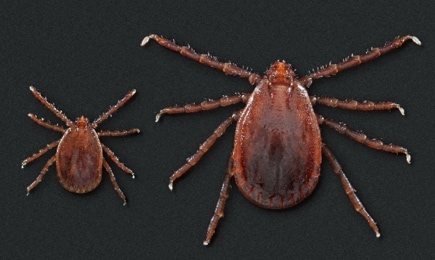
Ticks might be tiny, but the diseases they spread are anything but small. Prevention is the most effective way to protect yourself, but misinformation can get in the way. Unfortunately, there’s a lot of bad advice floating around about ticks and the diseases they transmit.
Let’s take a closer look at some of the most widespread tick myths and set the record straight.
Myths About Ticks
Myth #1: Ticks only live in the woods
Many people assume that ticks are only a threat if you’re hiking through dense forests or camping off the beaten path. While those are certainly tick-heavy environments, they’re far from the only places ticks hang out. The truth is, ticks are incredibly adaptable. They can be found in suburban backyards, city parks, playgrounds, beach dunes, grassy sports fields, and even around your own garden. Anywhere with tall grass, shrubs, leaf litter, or wildlife is fair game.
Myth #2: Ticks can jump or fly
Ticks don’t jump, fly, or fall from trees. Instead, they wait on tall grass or brush with their front legs outstretched- a behavior called “questing”- and latch on when a person or animal brushes past.
Myth #3: Ticks are only active in the summer
While tick activity- and tick bites- peak in the summer months, ticks can remain active well into fall. In some cases, ticks (primarily blacklegged (deer) ticks) can still be active during winter months if temperatures are above freezing. Don’t let your guard down once summer ends- tick prevention is a year-round effort.
Myths About Tick Removal
Myth #1: Smothering or burning a tick is a safe method
It’s a persistent rumor: if you cover a tick in petroleum jelly, dish soap, or essential oils- or if you burn it with a match- it’ll “back out” of the skin on its own. Unfortunately, whether the tick releases or not, doing this may actually make things worse. When you stress or irritate a feeding tick, it may regurgitate into your wound, making it more likely that pathogens, if present, will be transmitted.
Myth #2: It’s best to twist ticks to remove them
Twisting a tick during removal can cause its mouthparts to break off and remain embedded in the skin, increasing the risk of irritation or infection. The safest method is to pull straight upward with steady, even pressure using a tick remover or fine-tipped tweezers.
Myth #3: You can remove ticks using your fingers / fingernails
Using your fingers or nails to pinch and pull a tick often means squeezing it by the body, which (like smothering or burning) can cause the tick to regurgitate into the bite zone, increasing likelihood of disease transmission. This method also increases the risk of leaving parts of the tick behind. Always use a proper tick removal tool or fine-tipped tweezers for safe, effective removal.
Myths About Tick Bites
Myth #1: You will feel when a tick bites you
Tick bites don’t usually feel like anything. The only way to catch a tick early is to check your skin (and your pet’s fur!) carefully after outdoor activity. Pay special attention to areas like your scalp, hairline, behind your ears, under your arms, around your waistband, and behind your knees.
Myth #2: If you’ve been bitten you’ll definitely become sick
Not every tick carries disease, and even if a tick is infected, transmission isn’t guaranteed- especially if the tick is removed promptly and properly. Most tick-borne illnesses require the tick to be attached for some time before infection can occur. Early removal greatly reduces your risk.
Myth #3: If a tick’s head breaks off, you must remove it
While it’s ideal to remove the entire tick, if the mouthparts remain in the skin, you should not attempt to remove them. Trying to dig them out can cause more irritation or infection. It’s usually best to clean the area and let the skin expel them naturally.
Myths About Lyme & Other Tickborne Diseases
Myth #1: Only blacklegged (deer) ticks carry disease
While blacklegged ticks are the primary carriers of Lyme disease, they’re not the only dangerous species. Other ticks, like the Lone Star tick and American dog tick, can transmit serious illnesses such as ehrlichiosis, tularemia, and Rocky Mountain spotted fever. Different regions have different tick threats, so it’s important to stay informed no matter where you live.
Myth #2: Lyme disease always causes a bullseye rash
While the classic bullseye rash is the most recognizable sign of Lyme disease, it doesn’t appear in every case. In fact, many people never develop a rash at all. Relying solely on this symptom can delay diagnosis, so it’s important to watch for other early signs like fever, fatigue, joint pain, and flu-like symptoms.
Myth #3: You’ll test positive For Lyme immediately
Lyme disease tests detect your body’s response, not the bacteria itself. As this takes time to develop, testing too soon after a bite may lead to a false negative. If Lyme is suspected, doctors may base early treatment on symptoms and exposure history, not test results alone. This is why testing the tick itself can be helpful- it will tell you if the tick which bit you is a carrier.
Myth #4: Pets don’t get tick-borne illnesses
Pets, especially dogs, can be just as vulnerable to tick-borne diseases as humans. They can contract illnesses like Lyme disease, ehrlichiosis, and anaplasmosis. Unlike humans, dogs cannot tell us what symptoms they may be experiencing, making early diagnosis more challenging.
Staying Safe Starts with the Facts
Ticks are more than just a nuisance – they’re a growing public health concern. But with the right information and tools, you can dramatically reduce your risk. Smart prevention, daily tick checks, and proper removal techniques go a long way.




